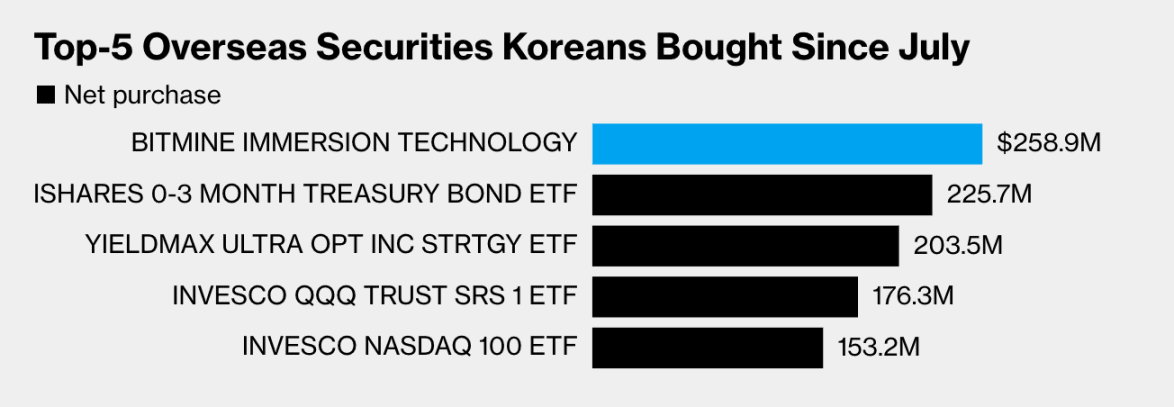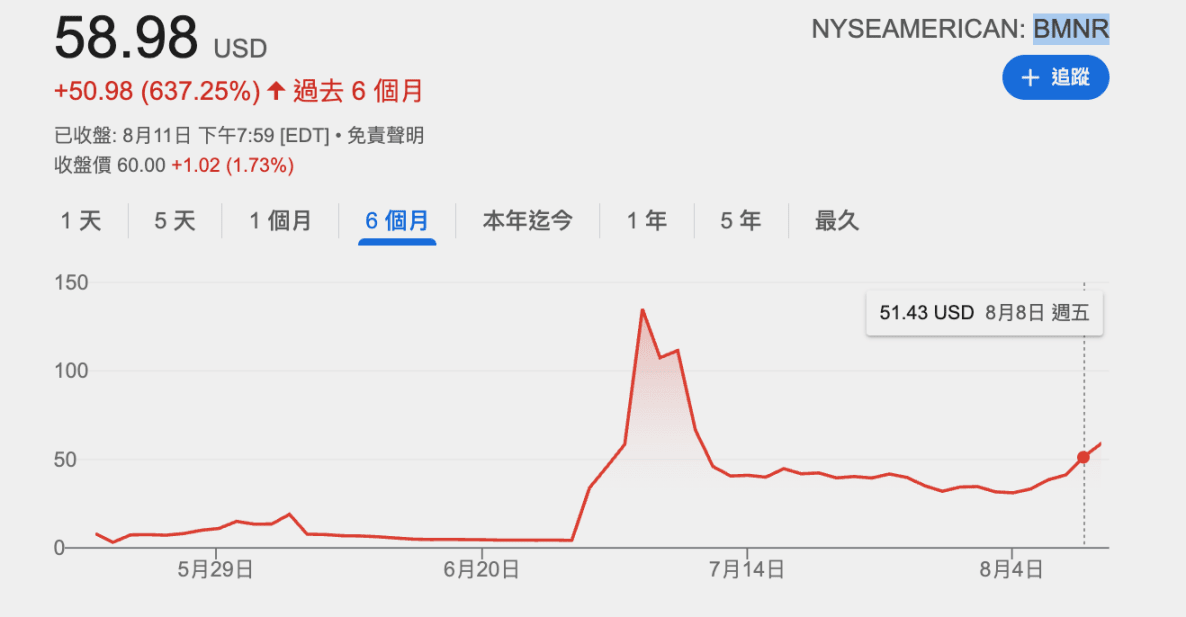The crypto trading craze in South Korea has quietly surged into the 'stock market.' The 'kimchi premium' of that year was once a spectacle in the global cryptocurrency market. In this country of only 51 million people, there was once a trading volume of Bitcoin sufficient to shake the global market. Although the government’s strong regulations have made this premium phenomenon a thing of the past, the adventurous spirit of South Koreans has not diminished; they are just looking for new outlets.
Moreover, the main force behind this frenzy is not South Korean institutional giants but the younger generation of retail investors betting on their future. In this country of 51 million people, as many as 18 million people are active in the digital asset market, accounting for over one-third of the total population, and among them, nearly a quarter of young people aged 20 to 39 view trading cryptocurrencies as their only chance to turn their lives around.
BitMine is the latest trading target.
According to data from South Korea's securities custody agency cited by Bloomberg, South Korean investors have injected a net amount of $259 million into BitMine stocks since July, making BitMine the top choice on the list of overseas stocks purchased by South Koreans.

BitMine is a U.S. Bitcoin mining company supported by 'Silicon Valley King' Peter Thiel, which has recently transitioned from Bitcoin mining to adopting ETH as its financial strategy, currently holding over 1.15 million ETH, valued at over $4.96 billion. This makes it an important 'vault' of ETH on Wall Street. Interestingly, Tom Lee, an important promoter bringing ETH to Wall Street, is also a director of BitMine.
Tom Lee is a Korean American. After experiencing the bloody lesson from the collapse of LUNA coin, South Korean investors' enthusiasm for risk assets has not diminished. At this time, the appearance of a 'fellow' who has achieved great success in finance from overseas undoubtedly garners high trust and attention. For South Korean retail investors, this is not just the opinion of an industry expert but also a call with national sentiment. This subtle cultural identity further strengthens their confidence and enthusiasm in the crypto market.
Why not buy ETH directly?
A key question then arises: Since they are optimistic about Ethereum, why not buy ETH directly instead of going around in a big circle to buy BitMine's stock?
Volatility may be the answer. Although cryptocurrencies are known for their extreme volatility, some retail investors may believe that participating through the stock market can provide a different risk exposure.
In actual backtesting, the price of ETH rose from $2,500 to $3,800 in July, an increase of 52%. During this period, BitMine stock BMNR rose from $46 on July 1 to a peak of $135, with a maximum increase of 193%.
As of the time of writing, ETH has risen to $4,300, the highest level since December 2021. Meanwhile, the price of BMNR has only slightly rebounded to $58.98. Risk-seeking South Koreans seem to prefer more volatile investment products, even though this 'roller coaster' of ups and downs can cause countless retail investors chasing highs to fall from the clouds.

However, the direct trading volume of ETH is not low either; in July alone, the ETH trading volume on South Korea's largest exchange, Upbit, was $111.1 billion, with net inflows currently unquantifiable.
BitMine is just a microcosm of the 'coin stock' frenzy.
However, this is not the first time South Koreans have rushed into 'coin stocks.' When the stablecoin company Circle went public, it attracted the attention of South Korean investors, with net purchases reaching $450 million in the month of its listing, pushing Circle's price-to-earnings ratio to 187 times, a number far exceeding any reasonable valuation for traditional fintech companies.
This frenzy has also swept the South Korean domestic market. With the new government's crypto-friendly policies, retail investors are filled with expectations, which is also part of the reason driving the Korean composite stock price index to a nearly four-year high. When the Bank of Korea announced the launch of a digital currency project (CBDC), retail investors sensed an opportunity. The stock prices of companies involved in the projects, such as Kakao Pay and LG CNS, seemed to rocket in a short period. Kakao Pay's stock price doubled in just one month, while LG CNS also followed closely, soaring nearly 70%.
When the craze finally subsides.
The craze for 'crypto-related stocks' in South Korea is more a reflection of deep social phenomena than a financial phenomenon. It shows how young people in South Korea are eagerly seeking non-traditional, high-risk breakthrough paths in an environment where traditional wealth accumulation channels are becoming increasingly narrow.
As Dragonfly's Hadick warns: 'When the premium disappears, investors will quickly sell off stocks, and these phenomena are usually short-lived.' The valuations of 'crypto-related stocks' pushed up by emotions and speculation may essentially be a huge bubble. When the craze finally subsides, who is swimming naked may only be revealed then. The crypto trading craze in South Korea has quietly surged into the 'stock market.' The 'kimchi premium' of that year was once a spectacle in the global cryptocurrency market. In this country of only 51 million people, there was once a trading volume of Bitcoin sufficient to shake the global market. Although the government’s strong regulations have made this premium phenomenon a thing of the past, the adventurous spirit of South Koreans has not diminished; they are just looking for new outlets.
Moreover, the main force behind this frenzy is not South Korean institutional giants but the younger generation of retail investors betting on their future. In this country of 51 million people, as many as 18 million people are active in the digital asset market, accounting for over one-third of the total population, and among them, nearly a quarter of young people aged 20 to 39 view trading cryptocurrencies as their only chance to turn their lives around.
BitMine is the latest trading target.
According to data from South Korea's securities custody agency cited by Bloomberg, South Korean investors have injected a net amount of $259 million into BitMine stocks since July, making BitMine the top choice on the list of overseas stocks purchased by South Koreans.

BitMine is a U.S. Bitcoin mining company supported by 'Silicon Valley King' Peter Thiel, which has recently transitioned from Bitcoin mining to adopting ETH as its financial strategy, currently holding over 1.15 million ETH, valued at over $4.96 billion. This makes it an important 'vault' of ETH on Wall Street. Interestingly, Tom Lee, an important promoter bringing ETH to Wall Street, is also a director of BitMine.
Tom Lee is a Korean American. After experiencing the bloody lesson from the collapse of LUNA coin, South Korean investors' enthusiasm for risk assets has not diminished. At this time, the appearance of a 'fellow' who has achieved great success in finance from overseas undoubtedly garners high trust and attention. For South Korean retail investors, this is not just the opinion of an industry expert but also a call with national sentiment. This subtle cultural identity further strengthens their confidence and enthusiasm in the crypto market.
Why not buy ETH directly?
A key question then arises: Since they are optimistic about Ethereum, why not buy ETH directly instead of going around in a big circle to buy BitMine's stock?
Volatility may be the answer. Although cryptocurrencies are known for their extreme volatility, some retail investors may believe that participating through the stock market can provide a different risk exposure.
In actual backtesting, the price of ETH rose from $2,500 to $3,800 in July, an increase of 52%. During this period, BitMine stock BMNR rose from $46 on July 1 to a peak of $135, with a maximum increase of 193%.
As of the time of writing, ETH has risen to $4,300, the highest level since December 2021. Meanwhile, the price of BMNR has only slightly rebounded to $58.98. Risk-seeking South Koreans seem to prefer more volatile investment products, even though this 'roller coaster' of ups and downs can cause countless retail investors chasing highs to fall from the clouds.

However, the direct trading volume of ETH is not low either; in July alone, the ETH trading volume on South Korea's largest exchange, Upbit, was $111.1 billion, with net inflows currently unquantifiable.
BitMine is just a microcosm of the 'coin stock' frenzy.
However, this is not the first time South Koreans have rushed into 'coin stocks.' When the stablecoin company Circle went public, it attracted the attention of South Korean investors, with net purchases reaching $450 million in the month of its listing, pushing Circle's price-to-earnings ratio to 187 times, a number far exceeding any reasonable valuation for traditional fintech companies.
This frenzy has also swept the South Korean domestic market. With the new government's crypto-friendly policies, retail investors are filled with expectations, which is also part of the reason driving the Korean composite stock price index to a nearly four-year high. When the Bank of Korea announced the launch of a digital currency project (CBDC), retail investors sensed an opportunity. The stock prices of companies involved in the projects, such as Kakao Pay and LG CNS, seemed to rocket in a short period. Kakao Pay's stock price doubled in just one month, while LG CNS also followed closely, soaring nearly 70%.
When the craze finally subsides.
The craze for 'crypto-related stocks' in South Korea is more a reflection of deep social phenomena than a financial phenomenon. It shows how young people in South Korea are eagerly seeking non-traditional, high-risk breakthrough paths in an environment where traditional wealth accumulation channels are becoming increasingly narrow.
As Dragonfly's Hadick warns: 'When the premium disappears, investors will quickly sell off stocks, and these phenomena are usually short-lived.' The valuations of 'crypto-related stocks' pushed up by emotions and speculation may essentially be a huge bubble. When the craze finally subsides, who is swimming naked may only be revealed then.


